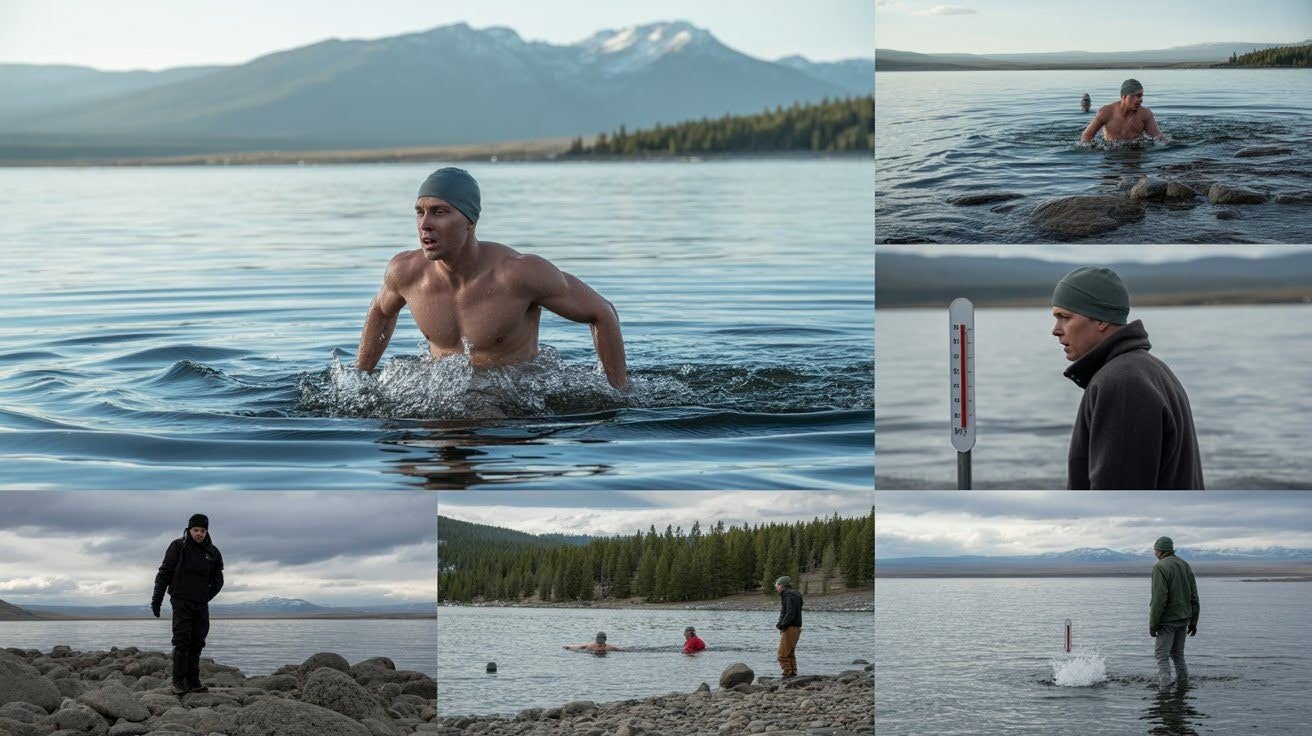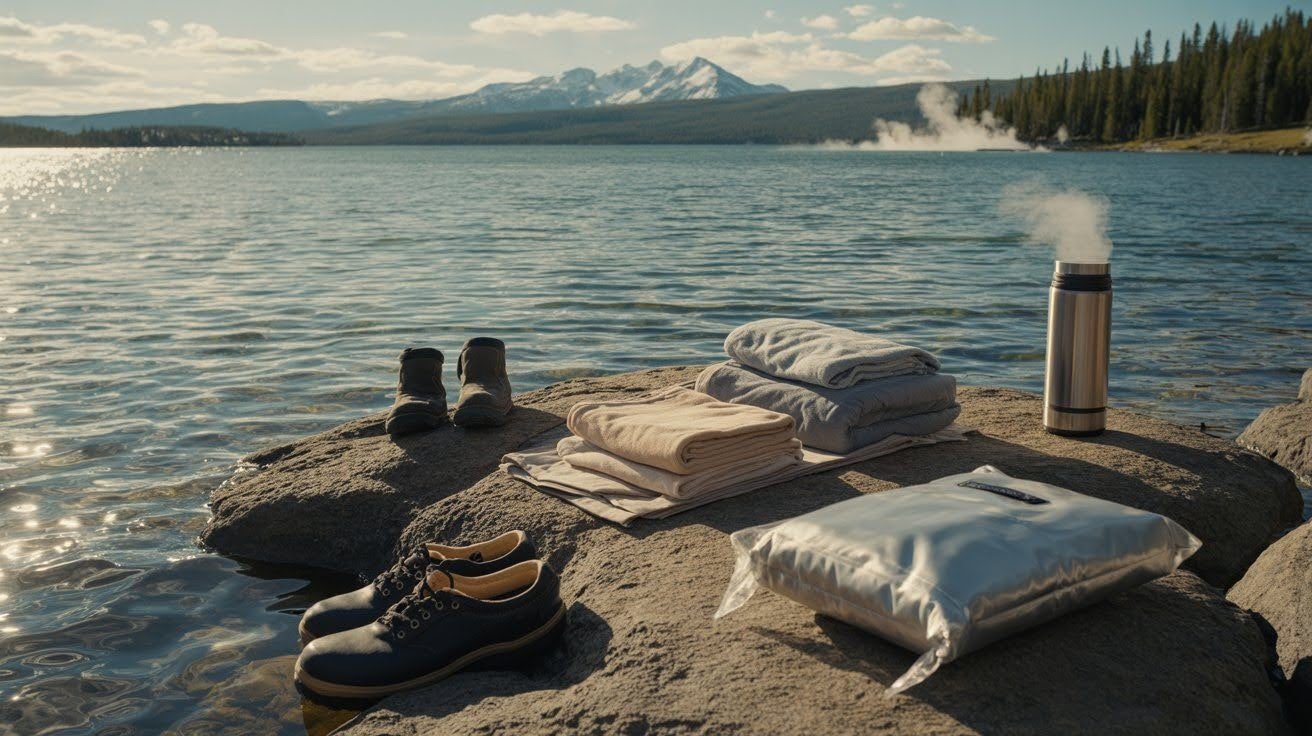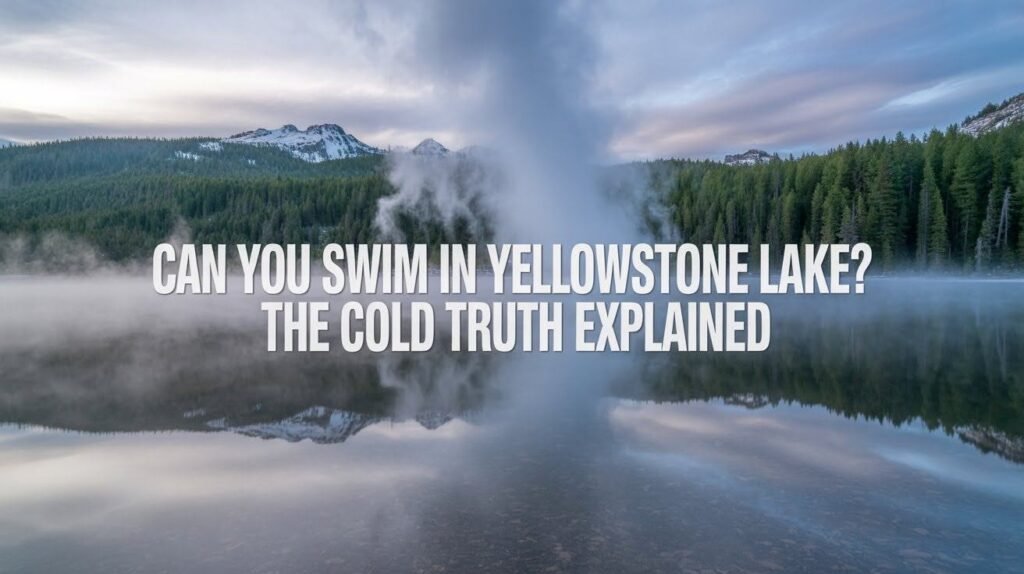In this blog, we know more about Yellowstone Lake. The lake covers 136 square miles in Yellowstone National Park. It’s clear waters and mountain views attract millions of visitors every year. Many wonder if it is safe to swim in the lake.
Swimming is allowed. But the lake presents serious challenges. The water stays very cold all year. Even in summer, temperatures can be near freezing. Sudden weather changes can make conditions dangerous. Strong winds and waves appear quickly.
Visitors should know what to expect. Only experienced swimmers or those with proper gear should enter the water. Staying close to shore is safer than venturing far. Always check weather forecasts before swimming. Carry a dry towel and warm clothes for after.
Can You Swim in Yellowstone Lake?

Yes, you can swim in Yellowstone Lake, but it’s allowed at your own risk. The National Park Service doesn’t provide lifeguards anywhere in the park. You’re completely responsible for your own safety if you decide to get in the water.
However, this isn’t your typical swimming spot. The water stays dangerously cold throughout the year. Even during summer months, the average temperature hovers around 41°F. That’s cold enough to take your breath away the moment you step in.
Most people who swim in Yellowstone Lake treat it like a polar plunge rather than a relaxing swim. Quick dips on hot summer days work best. Sedge Bay along the East Entrance Road is a popular access point. Just remember that legal doesn’t always mean safe or comfortable.
5 Reasons Why Swimming in Yellowstone Lake Is Challenging

Swimming in Yellowstone Lake tests even experienced swimmers. The conditions create obstacles that catch many visitors off guard.
Dangerously Cold Water Temperatures
The lake maintains an average temperature of 41°F even during peak summer. This extreme cold triggers an immediate shock response in your body. Your breathing becomes rapid and uncontrolled, making it hard to stay calm.
Your body loses heat 25 times faster in cold water than in cold air. Within minutes, your core temperature starts dropping. Your muscles get stiff, and simple movements become difficult. What seems like a quick, fun swim can turn serious fast.
Risk of Hypothermia Sets in Quickly
At a 40°F water temperature, an average person can lose consciousness within 15 to 30 minutes. Your body can’t generate heat fast enough to keep up with the loss. Exhaustion hits much sooner than you expect.
Air temperature plays a big role, too. Even on a warm day, wet skin exposed to mountain breezes accelerates heat loss. Confusion and poor judgment often develop before swimmers realize they’re in trouble. By the time you feel extremely cold, hypothermia may already be setting in.
The Lake Has Its Own Wave Patterns
Yellowstone Lake can produce surprisingly large waves with little warning. The lake’s size allows wind to build momentum across miles of open water. These waves create conditions similar to ocean swimming.
The water also develops patterns that act almost like tides. Currents shift and water levels change throughout the day. Calm conditions can turn rough quickly, leaving swimmers struggling to get back to shore.
High Elevation Affects Physical Performance
Yellowstone Lake sits at 7,733 feet above sea level. The thin air contains less oxygen than your body is used to at lower elevations. This affects your stamina and makes physical activity more tiring.
Your body has to work harder just to maintain normal functions. Combined with cold water stress, the high altitude makes recovery slower. You might feel fine going in, but find yourself exhausted trying to swim back.
Limited Warm-Up Facilities Nearby
Most swimming spots around the lake are in remote areas. You won’t find heated buildings or warming stations nearby. After getting out of the freezing water, you’re on your own to warm up.
The beaches consist mostly of rocks and pebbles. There’s nowhere comfortable to rest and recover. You’ll need to bring everything you might need because there are no facilities to help you.
Potential Hazards When Swimming in Yellowstone Lake
Before you consider swimming in Yellowstone Lake, understand the serious risks involved. Each hazard requires your full attention and respect.
- Hypothermia and Cold Water Shock: This is the biggest danger you’ll face. Early symptoms include uncontrollable shivering, confusion, and loss of coordination. As it gets worse, you might become disoriented or even lose consciousness. The cold water affects your body faster than most people realize.
- Drowning Risk: Cold water quickly reduces your ability to swim effectively. Your muscles don’t respond the way they should, and exhaustion sets in within minutes. Remember, there are no lifeguards anywhere in the park. If you get into trouble, help might not arrive in time.
- Thermal Features Near Shore: Some areas have underwater hot springs that can cause severe burns. These hot spots are unpredictable and hard to see. The temperature can shift from freezing to scalding within feet.
- Wildlife Encounters: Bears, moose, and other animals come to the shoreline regularly. They’re especially active during early morning and evening hours. A swimming person is vulnerable and could surprise an animal at close range.
- Sudden Weather Changes: Mountain weather changes with little warning. Clear skies can turn into thunderstorms quickly. Being in the water during a storm is extremely dangerous.
- Rocky Lake Bottom: Sharp rocks and uneven surfaces cover the lake floor. Slippery algae make footing treacherous. Cuts and twisted ankles happen easily when you can’t feel your feet from the cold.
- Distance from Medical Help: The lake sits in a remote location. Emergency responders need significant time to reach you. A minor problem can become life-threatening when help is far away.
These hazards make swimming in Yellowstone Lake a serious decision that shouldn’t be taken lightly.
Safety Guidelines for Swimming in Yellowstone Lake

If you still want to swim in Yellowstone Lake after understanding the risks, following these safety guidelines is essential. Proper preparation can mean the difference between a memorable experience and a dangerous situation.
- Know Your Limits Before Entering: Be honest about your cold water tolerance and overall fitness level. Only swim if you’re in excellent physical condition. People with heart conditions, respiratory problems, or circulation issues should avoid cold water swimming entirely. Never swim alone under any circumstances.
- Choose the Right Time and Location: Only swim during warm summer afternoons when air temperatures are highest. Sedge Bay provides good access with long stretches of beach. Always stay within a few feet of shore where you can touch bottom. Avoid any areas where you see steam or signs of thermal activity.
- Prepare Properly Before Your Swim: Pack warm, dry clothing and several towels in a waterproof bag. Bring a thermos filled with a hot drink. Wear water shoes to protect your feet from sharp rocks. Tell someone your plans and when you expect to return.
- Practice Safe Swimming Techniques: Wade in slowly to let your body adjust to the temperature. Limit your time in the water to just 2 to 3 minutes maximum. Keep your head above water to avoid swallowing lake water, which can contain harmful bacteria. Get out immediately if you feel numbness, confusion, or can’t stop shivering.
- What to Do After Swimming: Dry off right away and change into warm, dry clothes. Warm up gradually by adding layers rather than using extreme heat. Watch for signs of delayed hypothermia like continued shivering, drowsiness, or confusion. Rest and drink warm fluids before attempting to drive or hike.
Conclusion
Swimming in Yellowstone Lake is technically possible, but it requires careful planning and realistic expectations. The frigid water temperature of 41°F makes extended swimming impossible for most people. Even strong swimmers face serious risks from hypothermia and cold shock.
If you decide to try it, think of it as a quick, refreshing plunge on a hot day rather than a swimming session. Keep your time in the water brief and always have someone with you. Consider visiting the Firehole River Swimming Area or Boiling River instead, where warmer water makes for a more comfortable experience.
Your safety should always come first. The beauty of Yellowstone Lake can be enjoyed from the shore just as much as from the water. Know the risks, prepare properly, and never take chances with cold water.
Frequently Asked Questions
What Is the Best Time of Year to Swim in Yellowstone Lake?
Late July through August offers the warmest conditions, though the water still stays around 41°F. Air temperatures are highest during these months, which helps with warming up afterward.
Are There Any Warm Swimming Spots in Yellowstone National Park?
Yes, the Firehole River Swimming Area provides much warmer water for comfortable swimming. Boiling River offers another warm option when open, mixing hot springs with cold river water.
Do I Need a Permit to Swim in Yellowstone Lake?
No permit is required to swim in Yellowstone Lake. However, you must follow all park regulations and safety guidelines. Swimming is at your own risk.
What Should I Bring for a Safe Swimming Experience?
Essential items include warm clothing, multiple towels, water shoes, a thermos with hot beverages, and a basic first aid kit. Also, bring dry bags to keep things waterproof.
Can Children Safely Swim in Yellowstone Lake?
Children face higher risks because they lose body heat faster than adults. Extra caution is necessary, including shorter time in water, constant supervision, and immediate warming afterward.

